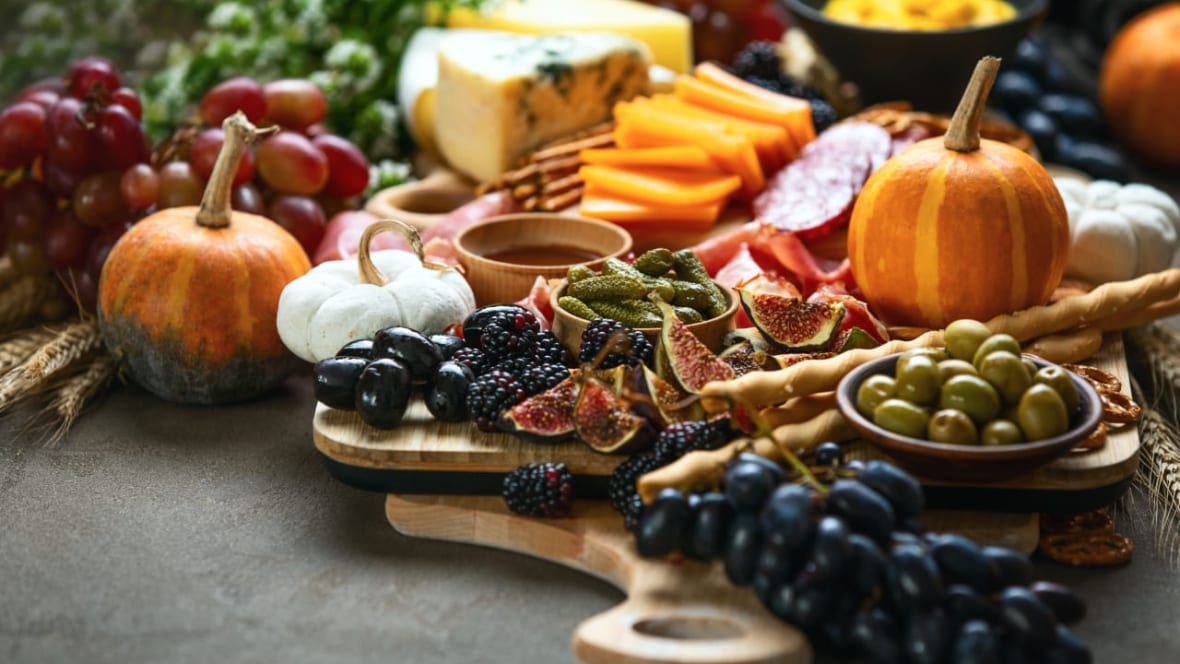How to make a crowd-pleasing charcuterie board
No matter what components you include, a charcuterie board is always an ideal opening act for holiday meals.
Pronouncing “charcuterie” might be more challenging than making a charcuterie board.
Americans say “shar-COO-tuh-ree” or ”shar-coo-tuh-REE,” the only difference being the syllable used for emphasis. The French say “shar-koo-TREE,” with emphasis on the last syllable.
In any language, charcuterie means delicious.

The French invented the concept of charcuterie in the 15th century, and since then, the collections of meats and cheeses have undergone several transformations. On the modern board, it’s not uncommon to see nuts, olives, fruit, and more that can serve as an appetizer course or as a main dish with a baguette and glass of wine.
What’s typically on a charcuterie board?
Cured meats. Prosciutto, capicola, soppressata and peperoni are all popular choices. Salami, chorizo, and Jamón Ibérico also make good choices.
Cheese: You can find a list online of the best cheeses for a charcuterie board, but I go with what I like. My favorites include gouda, goat, gorgonzola, butterkäse, and fresh mozzarella. But those who want more pungent cheeses should go for it.
What else? Meats and cheeses may be the stars, but you need supporting actors to round out the board.
Cornichons. These tiny gherkins make the perfect compliment. They’re tart and slightly briny, contrasting nicely with a softer cheese (like gouda) or cured meat (like capicola). Cornichons can be sweet, but some brands add red chili pepper to make them spicy. I don’t find the spicy ones overly hot, but I like the heat. Consider the sweet cornichons to be safe.
Fruit: Grapes work very well. Seedless grapes don’t have pits, so they’re neat. I love fresh cherries, but they’re sloppy to eat; you don’t want guests spitting out pits all over the pâté. Avoid any fruit that can oxidize and turn brown if left out too long, like apples. While you can certainly eat a brown apple, that look could ruin the appeal of your plate. You can also use dried fruits, like bananas, apricots, and figs.
Nuts: This also comes down to preference. I prefer unsalted nuts because there’s already enough salt in the cured meats, and I want to taste all the flavors. I like cashews because they’re so rich, and I’ll also add some unsalted peanuts and pecans. Walnuts, almonds, and macadamias work fine, too.
Pâté: I’m not a pâté fan, but I always have a little liver pâté on hand. You can make your own pâté, but it’s work—and why do that when you can buy perfectly good pâté at the store?
Foie gras: Some won’t eat the controversial delicacy made from the livers of geese or ducks. That’s because producers force-feed the animals to fatten them before slaughter, leading to claims of cruelty by animal rights activists. Still, it’s a popular French delicacy often used in French cuisine — and on charcuterie boards. If you’re going to purchase foie gras, buy the best grade possible. Outstanding foie gras has a buttery taste that melts in your mouth.
Salmon roe: This is an unusual option that you won’t see on most charcuterie recommendations, but one that I like. The roe adds a nice orange color to the array, pops in your mouth, and provides a flavor much different than what’s on the board. It’s also about 75% less than good caviar, making for a more affordable option. Good caviar costs $60 or more an ounce, and the cheap stuff that tastes like tin and fish isn’t worth buying.
Baguette, crackers, fig spread, spreadable cream cheese. I lumped all of these together for a reason. An excellent baguette topped with a bit of cream cheese and fig spread is full of flavor. The rich figs balance out the sweet and tangy cream cheese on a beautiful crunchy piece of bread. Buy your favorite crackers, spread on a bit of cream cheese, and top with a dollop of salmon roe. Heaven.
Olives: I don’t like them, so I don’t use them. But they are a staple. Use green, black, or a combination of the two.
No one has to use all of these items. A board with meat, cheese, cornichons, nuts, bread, or crackers would be just fine. But if you want to dress to impress, load up your board.
The term “charcuterie board” is a bit of a misnomer because you don’t need a special board for your charcuterie. I have a special board with fancy slide-out drawers, dainty knives, and spoons, but that’s optional for everyday entertaining.
You can simply use a large wood cutting board. The wood looks good, and it’s easy to arrange the food. You can also use a decorative platter with nice colors and designs.
Or you can use a large plate. The beauty of charcuterie is that it will be fantastic no matter what it’s on.

Ray Marcano is a longtime, award-winning journalist who has written and edited for some of the country’s most prominent media brands. He’s a former national president of the Society of Professional Journalists, a two-time Pulitzer juror, and a Fulbright Fellow.
TheGrio is FREE on your TV via Apple TV, Amazon Fire, Roku, and Android TV. TheGrio’s Black Podcast Network is free too. Download theGrio mobile apps today! Listen to ‘Writing Black’ with Maiysha Kai.
More About:Lifestyle Culture Watch




